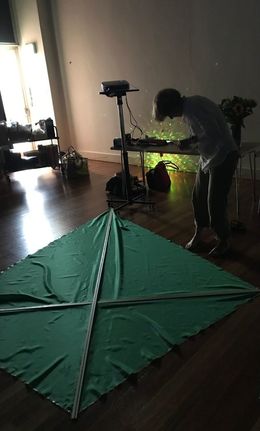 Last night I participated in the launch event at a conference for researchers and practitioners of music education for young children (MERYC). The proceedings began, appropriately, with a short performance sequence, for which I had a lot of fun devising the opening piece, which I performed with Professor Pam Burnard. A few people have said to me that they'd like to see the script, - so here it is, below. The poem therein (not reproduced here) – was part of 'Tap of the Baton' by Malcolm Guite. Previously, I had a very sticky weekend, making two giant kites to fly across the sides of the auditorium. We're, hoping that over the next four days people will fill the tails with the rhymes they remember from childhood. MUSICAL SPACES: ORIGINS, CULTURES AND CHILDHOODS INTRO SEQUENCE Tibetan bells. Lights down. AUDIO: Soundtrack 1: rhythmic sounds as heard in the womb: blood, breathing, heartbeat, amniotic fluid, father’s voice DEBBIE: Tap of a baton and the music starts, Con brio and Vivace, full of life … [1] The poem performance is accompanied by slides of the text with accompanying images. PAM: It all begins with sound. DEBBIE: It all begins with the body. PAM: It all begins in relationship and response. DEBBIE: While we were still in the womb, sound gave us the first hint of a world outside ourselves: a beating heart, the thud of footsteps, the music of a voice. PAM: And not just any sound, but rhythm and melody. DEBBIE: From this Musical Space of the womb, we move into the world and into language. But what we learn of language first is not vocabulary, not syntax. What we learn first are the rhythms, the cadences… AUDIO: Soundtrack 2: Baby sounds very quiet, gradually increasing in volume to final line and slide: infant directed speech, then child’s playing with sounds, then children chanting and singing rhymes. PAM: We imitate these sounds with our own body, our own breath. Stringing the musical building blocks together – playing with patterns in sound – is every child’s first foray into creativity. DEBBIE: And the adults around PAM: all join in! DEBBIE: With more sounds PAM: and songs, DEBBIE: and nursery rhymes. DEBBIE: So poetry, music and song all speak a primal language. PAM: Children’s language. DEBBIE: We carry these sensations in our bodies throughout our lives. The rhythms we hear and the melodies we make resonate with those deep memories from womb. PAM: Musical spaces where we feel safely held. DEBBIE: And poetry, music and song all have a special quality in relation to time. They all take place in time – but also make us us feel as if we have stepped outside time, or into a different quality of time. Musical space has its own time. AUDIO: Soundtrack 3: Children singing nursery rhymes sequence. PAM: Just like a musical space, a conference always seems to exist in its own time bubble. So now we step out of our own time – and into ‘conference time’ – into MERYC conference time. So, welcome to … Creating Musical Spaces: Origins, Cultures and Childhoods. Let the music begin … [1] 'Tap of the Baton' by Malcolm Guite is from Parable and Paradox, Canterbury Press (2016)
5 Comments
|
AuthorStill me … Archives
September 2020
Categories
All
|
